Development and Validation of an Observational Game Analysis Tool with Artificial Intelligence for Handball: Handball.ai
Abstract
:1. Introduction
2. Materials and Methods
2.1. Procedures
2.2. Participants
2.3. Observation Tool
2.4. Data Validation
3. Results
4. Discussion
5. Conclusions
Author Contributions
Funding
Institutional Review Board Statement
Informed Consent Statement
Data Availability Statement
Conflicts of Interest
References
- de la Rubia, A.; Ugalde-Ramírez, A.; Gutiérrez-Vargas, R.; Pino-Ortega, J. Does the New Resin-Free Molten D60 Ball Have an Impact on the Velocity and Accuracy of Handball Throws? Appl. Sci. 2022, 13, 425. [Google Scholar] [CrossRef]
- García-Aliaga, A.; Martín-Castellanos, A.; Marquina Nieto, M.; Muriarte Solana, D.; Resta, R.; López del Campo, R.; Mon-López, D.; Refoyo, I. Effect of Increasing the Number of Substitutions on Physical Performance during Periods of Congested Fixtures in Football. Sports 2023, 11, 25. [Google Scholar] [CrossRef] [PubMed]
- Ibáñez, S.J.; Piñar, M.I.; García, D.; Mancha-Triguero, D. Physical Fitness as a Predictor of Performance during Competition in Professional Women’s Basketball Players. Int. J. Environ. Res. Public Health 2023, 20, 988. [Google Scholar] [CrossRef] [PubMed]
- Kelly, A.L.; Williams, C.A.; Cook, R.; Sáiz, S.L.J.; Wilson, M.R. A Multidisciplinary Investigation into the Talent Development Processes at an English Football Academy: A Machine Learning Approach. Sports 2022, 10, 159. [Google Scholar] [CrossRef]
- Hughes, M. Notational Analysis. In Science and Soccer; Routledge: Oxford, UK, 2003; pp. 253–272. [Google Scholar]
- Anguera, M.T. Metodología Observacional. In Metodología de la Investigación en Ciencias del Comportamiento; Universidad de Murcia: Murcia, Spain, 1990; Volume 1, pp. 125–236. [Google Scholar]
- Anguera, M.T.; Hernández-Mendo, A. La Metodología Observacional En El Ámbito Del Deporte. Observational Methodology in Sport Sciences. Rev. Cienc. Deporte 2013, 9, 135–160. [Google Scholar]
- Anguera, M.T.; Blanco, A.; Losada, J.L. Diseños Observacionales, Cuestión Clave En El Proceso de La Metodología Observacional. Metodol. Cienc. Comport. 2001, 3, 135–161. [Google Scholar]
- Santos, S.; Sarmento, H.; Alves, J.; Campaniço, J. Construcción de Un Instrumento Para La Observación y El Análisis de Las Interacciones En El Waterpolo. Rev. Psicol. Deporte 2014, 23, 191–200. [Google Scholar]
- Atkinson, G.; Nevill, A. Measures of Reliability in Sports Medicine and Science. Sports Med. 2000, 30, 375–381. [Google Scholar] [CrossRef]
- O’Donoghue, P. Reliability Issues in Performance Analysis. Int. J. Perform. Anal. Sport 2007, 7, 35–48. [Google Scholar] [CrossRef]
- Ávila-Moreno, F.M.; Chirosa-Ríos, L.J.; Ureña-Espá, A.; Lozano-Jarque, D.; Ulloa-Díaz, D. Evaluation of Tactical Performance in Invasion Team Sports: A Systematic Review. Int. J. Perform. Anal. Sport 2018, 18, 195–216. [Google Scholar] [CrossRef]
- Clemente, F.M.; Praça, G.; Oliveira, R.; Aquino, R.; Araújo, R.; Silva, R.; Sarmento, H.; Afonso, J. A Systematic Review of the Criterion Validity and Reliability of Technical and Tactical Field-Based Tests in Soccer. Int. J. Sports Sci. Coach. 2022, 17, 1462–1487. [Google Scholar] [CrossRef]
- Reis, C.P.; Morales, J.C.P.; Gomes, C.M.A.; Pereira, F.D.A.A.; Ibáñez, S.J. Construct Validation of a New Instrument to Measure Declarative Tactical Knowledge in Basketball. Percept. Mot. Skills 2021, 128, 1712–1729. [Google Scholar] [CrossRef] [PubMed]
- Vučković, I.; Gadžić, A.; Sekulić, Ž.; Marković, S. Validnost I Pouzdanost Testa Za Procenu Vremena Reakcije I Brzine Kretanja U Odbrambenom Kosarkaskom Stavu. Facta Univ. Ser. Phys. Educ. Sport 2022, 20, 61–71. [Google Scholar] [CrossRef]
- Gottlieb, R.; Shalom, A.; Alcaraz, P.E.; Calleja-González, J. Validity and Reliability of a Unique Aerobic Field Test for Estimating VO2max among Basketball Players. Sci. J. Sport Perform. 2022, 1, 112–123. [Google Scholar] [CrossRef]
- Villarejo, D.; Ortega, E.; Gómez, M.-Á.; Palao, J.-M. Design, Validation, and Reliability of an Observational Instrument for Ball Possessions in Rugby Union. Int. J. Perform. Anal. Sport 2014, 14, 955–967. [Google Scholar] [CrossRef]
- Sabio Lago, Y.S.; Balic, M.G.; Sanromà, J.C.; Solá-Santesmases, J.; Argudo Iturriaga, F. Design, Validation and Reliability of an Instrument to Analyze Technical-Tactical Actions in Water Polo. Retos Nuevas Perspect. Educ. Física Deporte Recreación 2018, 34, 57–65. [Google Scholar]
- Nadeau, L.; Richard, J.-F.; Godbout, P. The Validity and Reliability of a Performance Assessment Procedure in Ice Hockey. Phys. Educ. Sport Pedagog. 2008, 13, 65–83. [Google Scholar] [CrossRef]
- Prieto, J.; Gómez-Ruano, M.A.; Sampaio, J. From a Static to a Dynamic Perspective in Handball Match Anal-Ysis: A Systematic Review. Open Sports Med. J. 2015, 8, 25–34. [Google Scholar]
- Lozano Jarque, D.; Camerino Foguet, O. Eficacia de Los Sistemas Ofensivos En Balonmano. Apunt. Educ. Física Deportes 2012, 2, 70–81. [Google Scholar] [CrossRef]
- Lozano, D.; Camerino, O.; Hileno, R. Análisis Del Comportamiento Táctico Ofensivo En Momentos Críticos de Juego En El Alto Rendimiento En Balonmano: Un Estudio Mixed Methods. Cuad. Psicol. Deporte 2016, 16, 151–160. [Google Scholar]
- Jiménez-Salas, J.; Hernández-Mendo, A. Analysis of Data Quality and Generalizability Observing System Counter in Elite Handball. Rev. Cienc. Deporte 2016, 12, 35–44. [Google Scholar]
- González Ramírez, A. Fiabilidad de Un Instrumento de Observación Para Analizar El Rendimiento En Handball. Cienc. Psicológicas 2016, 10, 199–207. [Google Scholar] [CrossRef]
- Pic, M. The Observation of Gender Differences in Handball. Rev. Cienc. Deporte 2017, 13, 191–198. [Google Scholar]
- Tulha Duarte Ferreira, A.L.; Santos Graça, A.B.; Dias Estriga, M.L. Development and Validation of an Individual Technical-Tactical Assessment System at Handball: The Handball Tactical Performance Evaluation (HTPE). J. Sports Sci. 2018, 14, 141–154. [Google Scholar]
- Quiñones Rodríguez, Y.; Morillo-Baro, J.P.; Reigal, R.E.; Morales-Sánchez, V.; Vázquez-Diz, J.A.; Hernández-Mendo, A. El Ataque Posicional En Balonmano: Validación de Un Sistema de Observación. Cuad. Psicol. Deporte 2019, 19, 113–124. [Google Scholar] [CrossRef] [Green Version]
- Ferrari, W.R.; Vaz, V.; Sousa, T.; Sarmento, H.; Dias, G. Development and Validation of a Notational Instrument to Study the Offensive Process in Handball. J. Sport Pedagog. Res. 2018, 4, 27–34. [Google Scholar]
- Montoya Fernández, M.; Moras i Feliu, G.; Anguera i Argilaga, M.T. Análisis de Las Finalizaciones de Los Extremos En Balonmano. Apunt. Educ. Física Deportes 2013, 113, 52–59. [Google Scholar] [CrossRef]
- Bilge, M. Game Analysis of Olympic, World and European Championships in Men’s Handball. J. Hum. Kinet. 2012, 35, 109–118. [Google Scholar] [CrossRef] [PubMed] [Green Version]
- Gutiérrez, Ó.; Ruiz, J.L. Data Envelopment Analysis and Cross-Efficiency Evaluation in the Management of Sports Teams: The Assessment of Game Performance of Players in the Spanish Handball League. J. Sport Manag. 2013, 27, 217–229. [Google Scholar] [CrossRef] [Green Version]
- Hassan, A. Team Handball World Cup Championship 2013—Analysis Study. J. Hum. Sport Exerc. 2014, 9, S409–S416. [Google Scholar] [CrossRef] [Green Version]
- Santos, F.M.; Fernandez, J.; Oliveira, M.C.; Leitão, C.; Anguera, T.; Campaniço, J. The Pivot Player in Handball and Patterns Detection—Instrument. Motricidade 2009, 5, 29–36. [Google Scholar] [CrossRef] [Green Version]
- Meletakos, P.; Vagenas, G.; Bayios, I. A Multivariate Assessment of Offensive Performance Indicators in Men’s Handball: Trends and Differences in the World Championships. Int. J. Perform. Anal. Sport 2011, 11, 284–294. [Google Scholar] [CrossRef]
- Ávila-Moreno, F.; Lozano-Jarque, D.; Chirosa-Ríos, L.J.; Ortega-Becerra, M. Design, Validation, and Reliability of an Observational Instrument Assessing Pivot Influence on Tactical Effectiveness in Team-Handball. Kinesiology 2022, 54, 166–174. [Google Scholar] [CrossRef]
- International Handball Federation (IHF). Rules of the Game; Indoor Handball: Copenhagen, Denmark, 2016. [Google Scholar]
- Prudente, J.N.; Cardoso, A.R.; Rodrigues, A.J.; Mendes, J.N.; Fernando, C.; Lopes, H.; Sousa, D.F. Playing 7 vs. 6 with an Empty Goal: Is It Really an Option for Coaches? A Comparative Analysis between Portugal and the Other Teams during the Men’s European Handball Championship 2020. Front. Psychol. 2022, 13, 809909. [Google Scholar] [CrossRef]
- Vázquez-Diz, J.A.; Morillo-Baro, J.P.; Reigal, R.E.; Morales-Sánchez, V.; Hernández-Mendo, A. Design and Validation of an Observational Instrument for Goalkeepers in Beach Handball Elaboração e Validação de Um Instrumento de Observação Para Guarda Redes de Andebol de Praia. Cuad. Psicol. Deporte 2019, 19, 135–146. [Google Scholar]
- Navarro, A.; Morillo, J.P.; Reigal, R.E.; Hernández-Mendo, A. Polar Coordinate Analysis in the Study of Positional Attacks in Beach Handball. Int. J. Perform. Anal. Sport 2018, 18, 151–167. [Google Scholar] [CrossRef]
- Font, R.; Daza, G.; Irurtia, A.; Tremps, V.; Cadens, M.; Mesas, J.A.; Iglesias, X. Analysis of the Variables Influencing Success in Elite Handball with Polar Coordinates. Sustainability 2022, 14, 15542. [Google Scholar] [CrossRef]
- Morillo, J.P.; Reigal, R.E.; Hernández-Mendo, A.; Montaña, A.; Morales-Sánchez, V. Decision-Making by Handball Referees: Design of an Ad Hoc Observation Instrument and Polar Coordinate Analysis. Front. Psychol. 2017, 8, 1842. [Google Scholar] [CrossRef] [Green Version]
- Host, K.; Pobar, M.; Ivasic-Kos, M. Analysis of Movement and Activities of Handball Players Using Deep Neural Networks. J. Imaging 2023, 9, 80. [Google Scholar] [CrossRef] [PubMed]
- Ding, P. Analysis of Artificial Intelligence (AI) Application in Sports. J. Phys. Conf. Ser. 2019, 1302, 032044. [Google Scholar] [CrossRef]
- Saavedra, J.M.; Þorgeirsson, S.; Chang, M.; Kristjánsdóttir, H.; García-Hermoso, A. Discriminatory Power of Women’s Handball Game-Related Statistics at the Olympic Games (2004–2016). J. Hum. Kinet. 2018, 62, 221–229. [Google Scholar] [CrossRef] [Green Version]
- Vuleta, D.; Sporiš, G.; Milanović, D. Indicators of Situational Efficiency of Winning and Defeated Male Handball Teams in Matches of the Olympic Tournament 2012. Acta Kinesiol. 2015, 9, 40–49. [Google Scholar]
- Milanović, D.; Vuleta, D.; Ohnjec, K. Performance Indicators of Winning and Defeated Female Handball Teams in Matches of the 2012 Olympic Games Tournament. J. Hum, Kinet. 2018, 64, 247–253. [Google Scholar] [CrossRef] [Green Version]
- Almeida, A.G.; Merlin, M.; Pinto, A.; Torres, R.D.S.; Cunha, S.A. Performance-Level Indicators of Male Elite Handball Teams. Int. J. Perform. Anal. Sport 2020, 20, 1–9. [Google Scholar] [CrossRef]
- de Paula, L.V.; Costa, F.E.; Ferreira, R.M.; Menezes, R.P.; Werneck, F.Z.; Coelho, E.F.; Greco, P.J. Analysis of Discriminatory Game Variables between Winners and Losers in Women’s Handball World Championships from 2007 to 2017. Kinesiology 2020, 52, 54–63. [Google Scholar] [CrossRef]
- Konstantinos, N.S.; Elissavet, R.N.; Panagiotis, G.M.; Ioannis, B.A.; Konstantinos, B.D. Performance Indicators and Competition Ranking in Women’s and Men’s World. J. Phys. Educ. Sport 2018, 18, 1761–1766. [Google Scholar]
- Daza, G.; Andrés, A.; Tarragó, R. Match Statistics as Predictors of Team’s Performance in Elite Competitive Handball. RICYDE Rev. Int. Cienc. Deporte 2017, 48, 149–161. [Google Scholar] [CrossRef]
- Meletakos, G.P.; Konstantinos, N.S.; Ioannis, B.A. Stable and Changing Characteristics of High-Level Handball as Evidenced from World Men’s Championships. J. Phys. Educ. Sport 2020, 20, 1354–1361. [Google Scholar]
- Skarbalius, A.; Pukenas, K.; Vidünaite, G. Sport Performance Profile in Men’s European Modern Handball: Discriminant Analysis between Winners and Losers. Balt. J. Health Phys. Act. 2013, 3, 44–54. [Google Scholar]
- Trejo-Silva, A.; Feu, S.; Camacho-Cardenosa, A.; Camacho-Cardenosa, M.; Brazo-Sayavera, J. Relation of Offensive Performance during Exclusions and Final Ranking in Female Handball. Appl. Sci. 2022, 12, 10774. [Google Scholar] [CrossRef]
- Ferrari, W.; Dias, G.; Sousa, T.; Sarmento, H.; Vaz, V. Comparative Analysis of the Offensive Effectiveness in Winner and Losing Handball Teams. Front. Psychol. 2020, 11, 547110. [Google Scholar] [CrossRef]
- Vaz, V.; Ferrari, W.; Sarmento, H.; Couceiro, M.; Sousa, T.; Dias, G. Handball Offensive Analysis: Comparative Evolution of Linear Tendency Lines between Finalist Teams in the EHF CL. Appl. Sci. 2023, 13, 1366. [Google Scholar] [CrossRef]
- Ohnjec, K.; Vuleta, D.; Milanović, D.; Gruić, I. Performance Indicators of Teams at the 2003 World Handball Championship for Women in Croatia. Kinesiology 2008, 40, 69–79. [Google Scholar]
- Gómez, M.Á.; Lago-Peñas, C.; Viaño, J.; González-Garcia, I. Effects of Game Location, Team Quality and Final Outcome on Game-Related Statistics in Professional Handball Close Games. Kinesiology 2014, 46, 249–257. [Google Scholar]
- Þorgeirsson, S.; Pic, M.; Lozano, D.; Sigurgeirsson, O.; Sekulic, D.; Saavedra, J.M. Gender-Based Differences in Game-Related Statistics between Winning and Losing Teams in an Amateur Handball League. Acta Gymnica 2022, 52, e2022. [Google Scholar] [CrossRef]
- Þorgeirsson, S.; Pic, M.; Lozano, D.; Sigurgeirsson, O.; Sekulic, D.; Saavedra, J.M. The Difference Between Winners and Losers in Balanced Handball Games in the Final 10 Minutes. Montenegrin J. Sports Sci. Med. 2022, 11, 37–43. [Google Scholar] [CrossRef]
- Antúnez-Medina, A.; Garcías-Rubia, J.; Sáez-Blázquez, F.J.; Valle-Blanco, A.; García-Martín, A. Differences in Performance Indicator between Winning and Losing Team in Formative Stages According to Sex and Final Score Differences. Rev. Cienc. Deporte 2013, 9, 5–16. [Google Scholar]
- Hatzimanouil, D. Goalkeeper’s Efficiency in Relation with Throws from Different Attacking Court Areas in Team Handball. J. Phys. Educ. Sports Manag. 2020, 7, 11–18. [Google Scholar] [CrossRef]
- Gümüş, H.; Gençoğlu, C. The Effects of the Goalkeeper Substitution Rule as a New Strategy in Handball: Analysis of Men’s European Handball Championship 2020. Acta Gymnica 2020, 50, 113–121. [Google Scholar] [CrossRef]
- Costa, G.D.C.T.; Pedrosa, G.F.; Souza, N.P.D.; Gemente, F.R.F.; Freire, A.B.; Castro, H.D.O. Type of Game Practiced in Handball According to the Positions of the Attackers: Analysis of the Women’s World Handball Championship 2015. Int. J. Perform. Anal. Sport 2017, 17, 360–373. [Google Scholar] [CrossRef]
- Wagner, H.; Hinz, M.; Melcher, K.; Radic, V.; Uhrmeister, J. The PlayerScore: A Systematic Game Observation Tool to Determine Individual Player Performance in Team Handball Competition. Appl. Sci. 2023, 13, 2327. [Google Scholar] [CrossRef]
- Pascual, A.; Font, R.; Pascual, X.; Lago-Peñas, C. Evolution of Match Performance Parameters in Elite Men’s Handball 2012–2022. Int. J. Sports Sci. Coach. 2023, 174795412211424. [Google Scholar] [CrossRef]
- Lago-Peñas, C.; Gómez, A.M.; Viaño, J.; González-García, I.; Fernández-Villarino, M. de L. ángeles Home Advantage in Elite Handball: The Impact of the Quality of Opposition on Team Performance. Int. J. Perform. Anal. Sport 2013, 13, 724–733. [Google Scholar] [CrossRef]
- Prieto, J.; Gómez, M.-Á.; Volossovitch, A.; Sampaio, J. Effects of Team Timeouts on the Teams’ Scoring Performance in Elite Handball Close Games. Kinesiology 2016, 48, 115–123. [Google Scholar] [CrossRef]
- Araújo, D.; Couceiro, M.; Seifert, L.; Sarmento, H.; Davids, K. Artificial Intelligence in Sport Performance Analysis; Routledge: New York, NY, USA, 2021; ISBN 9781003163589. [Google Scholar]
- Hughes, M.D.; Bartlett, R.M. The Use of Performance Indicators in Performance Analysis. J. Sports Sci. 2002, 20, 739–754. [Google Scholar] [CrossRef]
- Bulger, S.M.; Housner, L.D. Modified Delphi Investigation of Exercise Science in Physical Education Teacher Education. J. Teach. Phys. Educ. 2007, 26, 57–80. [Google Scholar] [CrossRef]
- Cohen, J. Statistical Power Analysis for the Behavioral Science, 2nd ed.; Lawrence Erlbaum Associates: New York, NY, USA, 1988; ISBN 0-8058-0283-5. [Google Scholar]
- Anguera, M.T.; Camerino, O.; Castañer, M.; Sánchez-Algarra, P.; Onwuegbuzie, A.J. The Specificity of Observational Studies in Physical Activity and Sports Sciences: Moving Forward in Mixed Methods Research and Proposals for Achieving Quantitative and Qualitative Symmetry. Front. Psychol. 2017, 8, 2196. [Google Scholar] [CrossRef] [Green Version]
- Blanco Villaseñor, A.; Losada, J.L.; Anguera, T. Data Analysis Techniques in Observational Designs Applied to the Environment-Behaviour Relation1 Analysis of Tactical-Tecnhical Performance in Team Handaball View Project. Medio Ambiente Comport. Hum. 2003, 4, 111–126. [Google Scholar]
- Heinemann, K. Introducción a la Metodología de la Investigación Empírica en Las Ciencias Del Deporte; Paidotribo: Barcelona, Spain, 2003. [Google Scholar]
- Fortes, A.M.; Gómez, M.A.; Hongyou, L.; Sampedro, J. Inter-Operator Reliability of VideobserverTM. Cuad. Psicol. Deporte 2016, 16, 137–152. [Google Scholar]
- O’Donoghue, P.; Holmes, L. Data Analysis in Sport; Routledge: London, UK, 2015. [Google Scholar]
- Altman, D.G. Practical Statistics for Medical Research; Chapman & Hall: London, UK, 1991. [Google Scholar]
- Peterson, R.A.; Kim, Y. On the Relationship between Coefficient Alpha and Composite Reliability. J. Appl. Psychol. 2013, 98, 194–198. [Google Scholar] [CrossRef]
- George, D.; Mallery, P. SPSS for Windows Step by Step: A Simple Guide and Reference (11.0 Update), 4th ed.; Allyn & Bacon: Boston, MA, USA, 2003. [Google Scholar]
- Koo, T.K.; Li, M.Y. A Guideline of Selecting and Reporting Intraclass Correlation Coefficients for Reliability Research. J. Chiropr. Med. 2016, 15, 155–163. [Google Scholar] [CrossRef] [Green Version]
- García-Martín, A.; Antúnez, A.; Ibáñez, S.J. Análisis Del Proceso Formativo En Jugadores Expertos: Validación de Instrumento/Analysis of Expert Players’ Training Process: Validation of Tools. Rev. Int. Med. Cienc. Act. Física Deporte 2016, 61. [Google Scholar] [CrossRef] [Green Version]
- Chacón-Moscoso, S.; Sanduvete-Chaves, S.; Anguera, M.T.; Losada, J.L.; Portell, M.; Lozano-Lozano, J.A. Preliminary Checklist for Reporting Observational Studies in Sports Areas: Content Validity. Front. Psychol. 2018, 9, 291. [Google Scholar] [CrossRef] [PubMed] [Green Version]
- Hernández-Mendo, A.; López, J.A.; Castellano, J.; Morales, V.; Pastrana, J.L. Program for Use in Methodology Observacional. Cuad. Psicol. Deporte 2012, 12, 55–78. [Google Scholar]
- Gabin, B.; Camerino, O.; Anguera, M.T.; Castañer, M. Lince: Multiplatform Sport Analysis Software. Procedia Soc. Behav. Sci. 2012, 46, 4692–4694. [Google Scholar] [CrossRef]
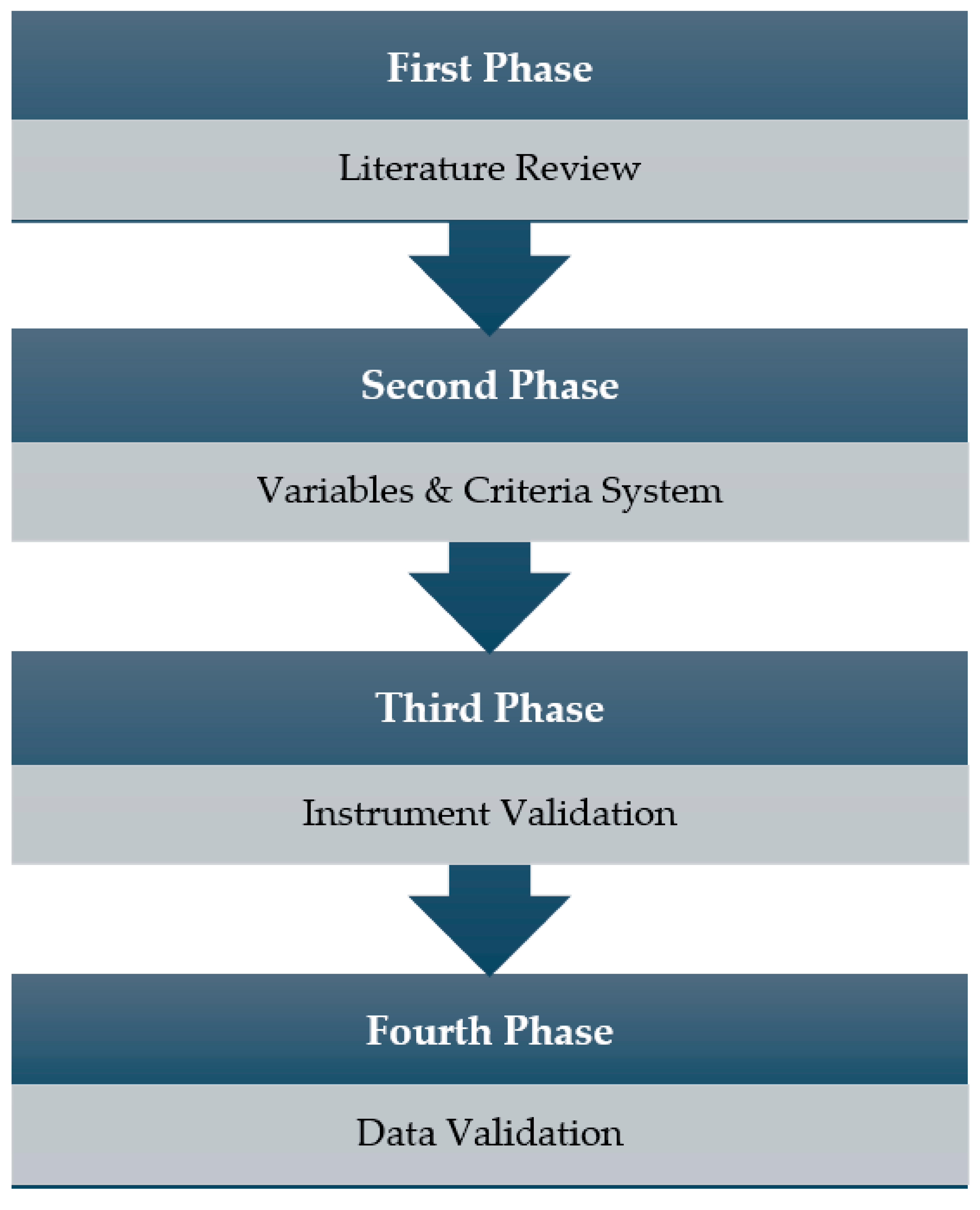
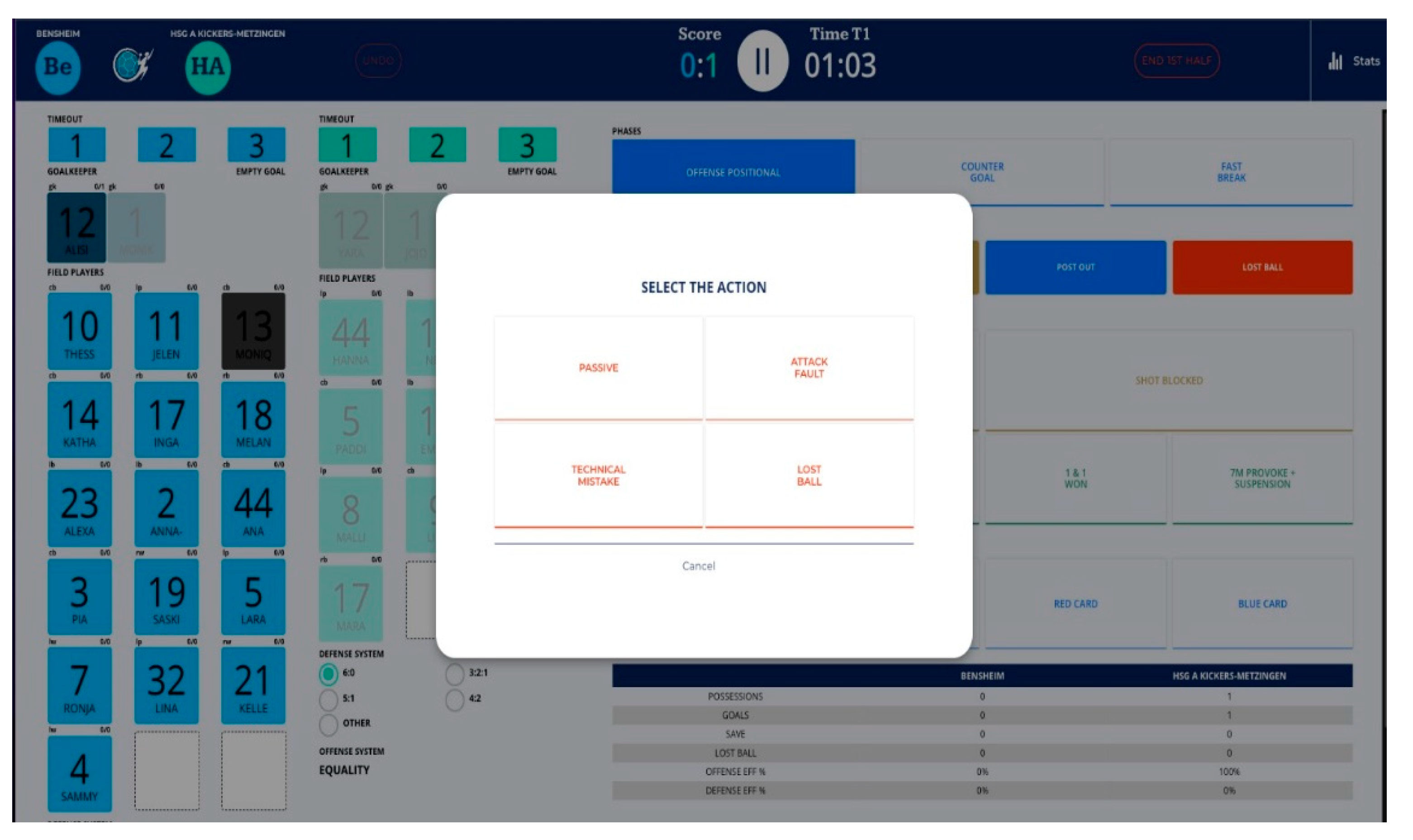
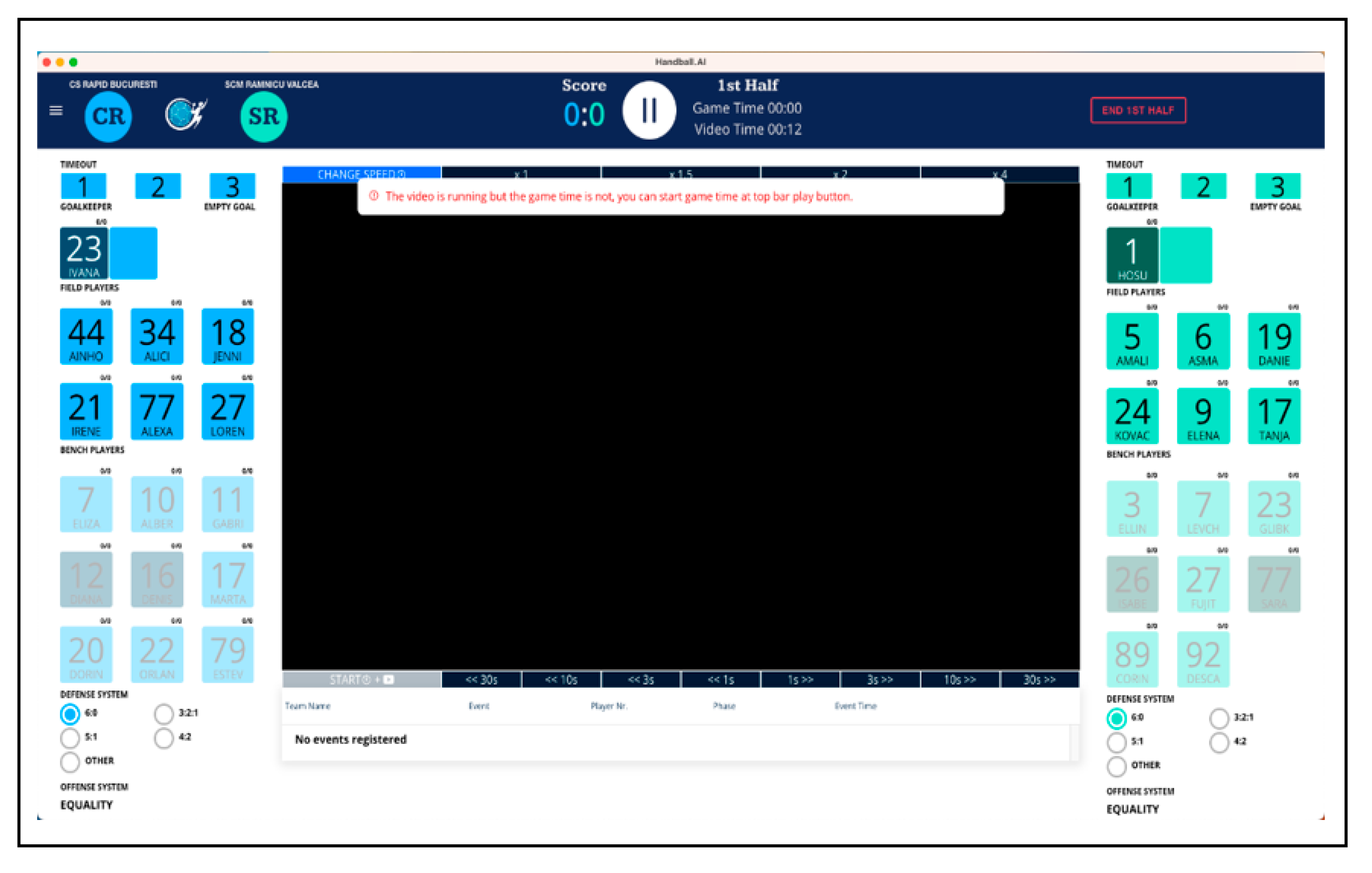
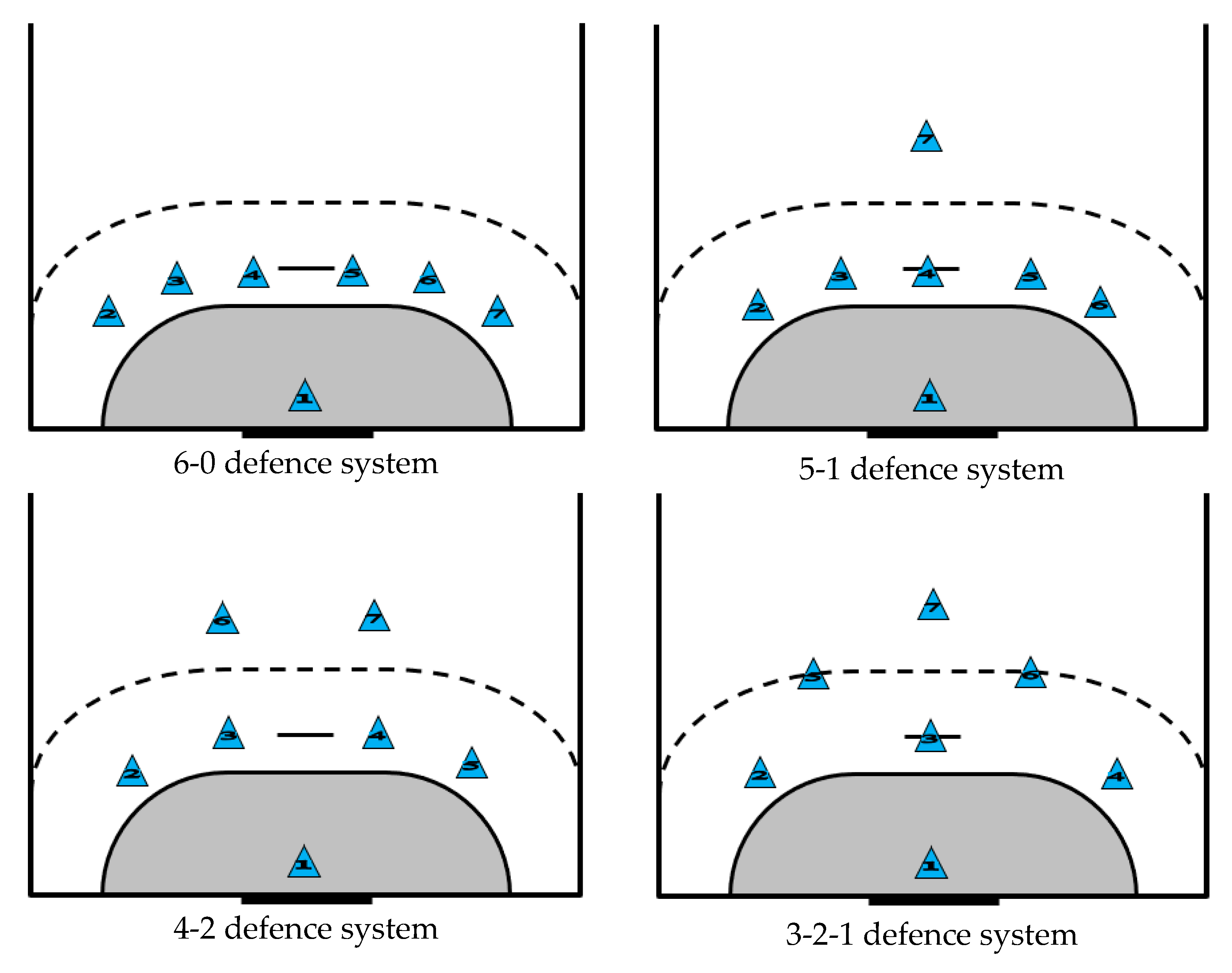

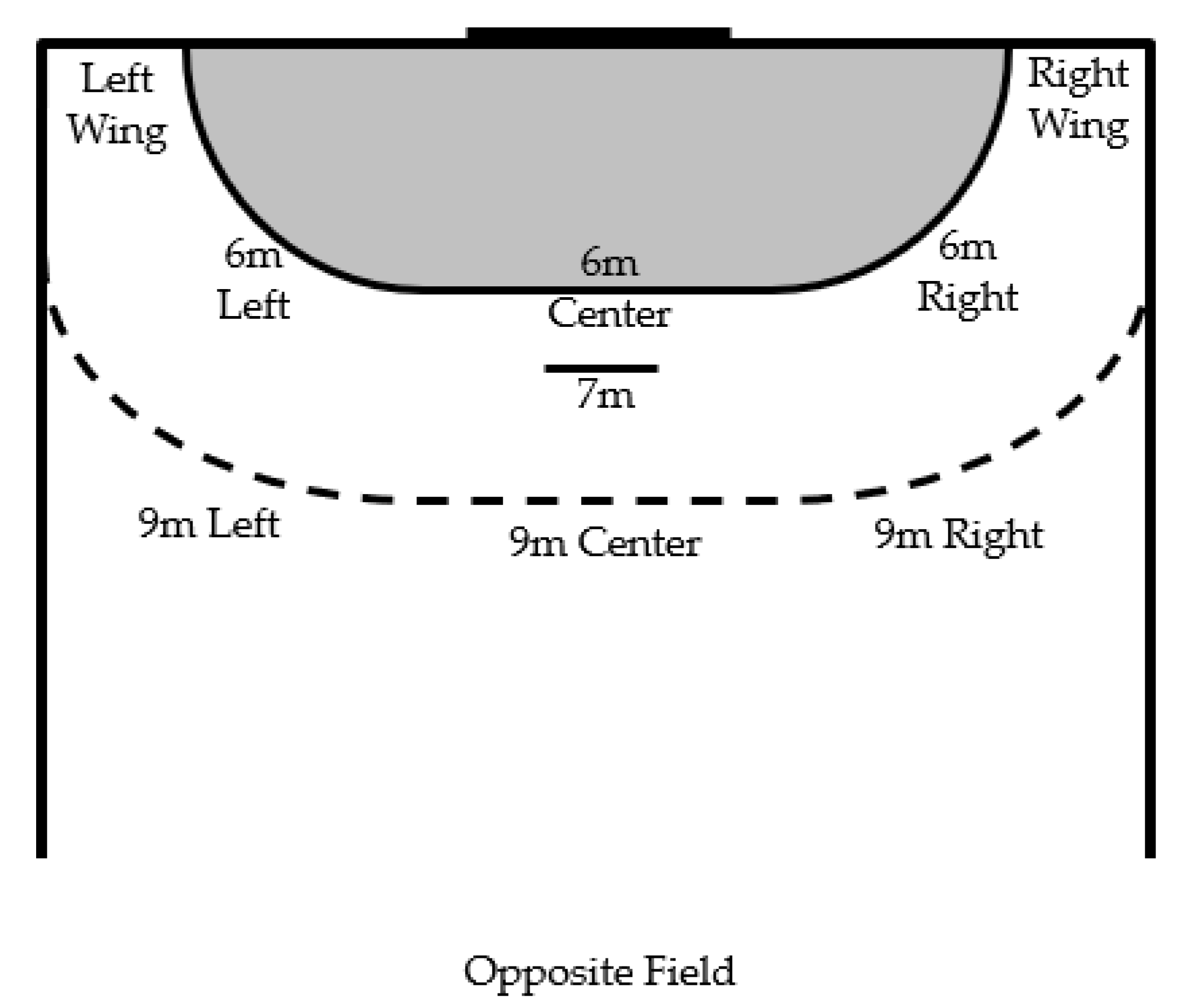
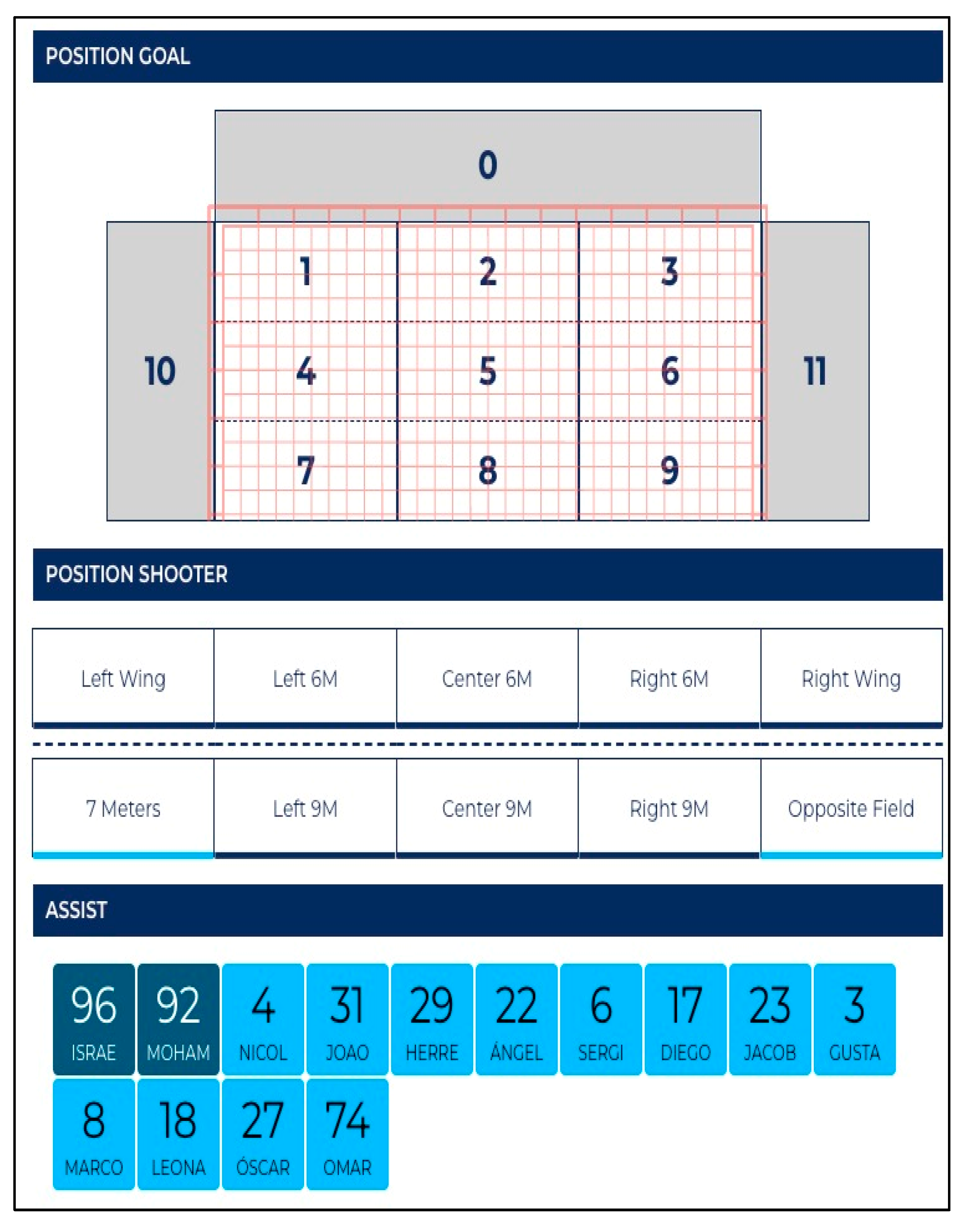
| Dimension | Variable | Definition |
|---|---|---|
| Period | First Half | Division of the time duration of a handball match. Comprises the first and second half. |
| Second Half | ||
| Team | Name | Name of each of the contending clubs or teams in the match. |
| Event | Goal | Moment that one team with the possession of the ball gets the ball into the opponent’s goal. |
| Save | Moment that the goalkeeper stops the ball from a shot by the opposing team. | |
| Post Out | Moment that one team with the possession of the ball realizes one shot, with the finality to score a goal, but the shot goes out or against the post. | |
| Attack Fault | Infraction committed by a player as a result of a foul on a defender indicated by the referee. | |
| Lost Ball | The attacking team loses ball possession, and the defending team takes ball possession. | |
| Technical Mistake | Loss of ball possession through a rule infringement, e.g., steps, double dribble. | |
| Passive | Infraction indicated by the referee if the team in ball possession does not change its attacking behaviour or does not take a throw-in after the referee has indicated the passive play warning. | |
| Fault | Stopping of an opposing player by the player in ball possession without generating any suspension (yellow card, red card, blue card and 2 min). | |
| Shot Blocked | Technical action of a defending player who intercepts the trajectory of the ball in a throwing attempt on goal. | |
| 2 min provoked | Player in ball possession attempts to score a goal and is illegally prevented from doing so by another player on defence, incurring a 2 min suspension. | |
| 7 m provoked | Player in ball possession tries to score a goal and another player on defence stops him, illegally interrupting a clear goal-scoring opportunity. | |
| 7 m provoked + 2 min suspension | Player in ball possession tries to score a goal and another player in defence stops him illegally, interrupting a clear goal-scoring opportunity and incurring a 2 min suspension. | |
| 1 × 1 Won | Player in ball possession overtakes the player on defence, generating a clear goal-scoring opportunity or a 7 m provoked, 2 min suspension and 7 m provoked + 2 min suspension. | |
| 2 min | Exclusion of a player for 2 min indicated by the referee due to repeated fouls, unsporting conduct, an incorrect change or as a result of a disqualification. | |
| Yellow Card | Disciplinary sanction awarded by the referee to a player and/or coaching staff member as a result of a fault or unsporting behaviour. | |
| Red Card | Disciplinary sanction awarded by the referee to a player and/or coaching staff member for severe misconduct or for receiving a 2 min suspension three times. | |
| Blue Card | Disciplinary sanction imposed by the referee on a player and/or coaching staff member as a consequence of serious misconduct or misconduct involving a written report. | |
| Phase | Positional Offense | Chance to score a goal by the attacking team against a structured defence. Action of attacking teams playing with structured attack in the opponent’s field. |
| Fastbreak | Recovery of ball possession by the defence due to an event (e.g., turnover) and this team searches for a clear action to score a goal against an unstructured defence. | |
| Countergoal | Recovery of ball possession by the defence due to a goal, and this team searches for a clear action to score a goal against an unstructured defence. | |
| Defence System | Structure that both teams have in any moment of defending time during handball game. | |
| Offense System | Structure that both teams have in any moment of attacking time during handball game. | |
| Offense Player Position | Playing position occupied by an offensive player on the court | |
| Defence Player Position | Playing position occupied by a defence player on the court | |
| Shooter Position | On the field (left wing, 6 m left, 6 m centre, 6 m right, right wing, 9 m left, 9 m centre, 9 m right, opposite field and 7 meters). | |
| Shot Location | (In the goal) with a difference in number 1, 2, 3 (from left to right up); 4, 5, 6 (from left to right in the middle); and 7,8,9 (from left to right down). | |
| Possession | Number of times that a player/team was involved in the possession of the ball, in general and in the different phases of the game (positional offense, countergoal and fastbreak). |
| Dimension | Tracking |
|---|---|
| Period | Automatic |
| Team | Automatic |
| Offense System | Automatic |
| Offense Player Position | Automatic |
| Defence Player Position | Automatic |
| Possession | Automatic |
| Duration | Automatic |
| Players | Automatic |
| Event | Manual |
| Phase | Manual |
| Defence System | Manual |
| Shooter Position | Manual |
| Shot Location | Manual |
| Expert 1 | Expert 2 | Expert 3 | Expert 4 | Expert 5 | Expert 6 | Expert 7 | Expert 8 | Expert 9 | Expert 10 | |
|---|---|---|---|---|---|---|---|---|---|---|
| Variables | κ | κ | κ | κ | κ | κ | κ | κ | κ | κ |
| Period | 1 | 1 | 1 | 1 | 1 | 1 | 1 | 1 | 1 | 1 |
| Team | 1 | 1 | 1 | 1 | 1 | 1 | 1 | 1 | 1 | 1 |
| Offense System | 1 | 0.78 | 1 | 0.78 | 1 | 0.8 | 1 | 0.78 | 1 | 0.82 |
| Offense Player Position | 0.79 | 0.64 | 0.82 | 0.64 | 0.78 | 0.78 | 0.64 | 0.64 | 0.78 | 0.78 |
| Defence Player Position | 0.81 | 0.78 | 0.83 | 0.78 | 0.82 | 0.82 | 0.78 | 0.78 | 0.82 | 0.82 |
| Possession | 1 | 1 | 1 | 1 | 1 | 1 | 1 | 1 | 1 | 1 |
| Duration | 0.8 | 0.82 | 0.79 | 0.82 | 0.78 | 0.82 | 0.82 | 0.82 | 0.82 | 0.82 |
| Players | 1 | 1 | 1 | 1 | 1 | 1 | 1 | 1 | 1 | 1 |
| Event | 1 | 1 | 1 | 1 | 0.82 | 1 | 0.82 | 1 | 0.82 | 1 |
| Phase | 0.8 | 0.78 | 0.61 | 0.78 | 0.78 | 0.82 | 0.78 | 0.78 | 0.78 | 0.82 |
| Defence System | 1 | 1 | 1 | 1 | 1 | 1 | 1 | 1 | 1 | 1 |
| Shooter Position | 0.79 | 0.82 | 0.78 | 0.82 | 0.82 | 0.78 | 0.82 | 0.82 | 0.78 | 0.78 |
| Shot Location | 0.81 | 0.78 | 0.77 | 0.78 | 0.8 | 0.8 | 0.8 | 0.78 | 0.8 | 0.8 |
| Mean | 0.908 | 0.877 | 0.892 | 0.877 | 0.892 | 0.894 | 0.882 | 0.877 | 0.892 | 0.895 |
| Total | 0.889 | |||||||||
| ANOVA (Sig) 1.000 F (0.101) | ||||||||||
| Intra-Observer | Inter-Observer | |||||
|---|---|---|---|---|---|---|
| Variable Group | α | ICC (95%) | κ | α | ICC (95%) | κ |
| Period | 1 | 1 | 1 | 0.995 | 0.989 | 0.929 |
| Team | 0.951 | 0.907 | 0.908 | 0.989 | 0.978 | 0.919 |
| Duration | - | 0.977 | 0.955 | 0.895 | 0.845 | - |
| Offense System | 0.986 | 0.972 | 0.98 | 0.992 | 0.984 | 0.91 |
| Offense Player Position | 0.982 | 0.965 | 0.958 | 0.984 | 0.969 | 0.915 |
| Possession | 1 | 1 | 0.976 | 1 | 1 | 0.958 |
| Team Players | - | 0.645 | - | - | 0.61 | |
| Mean | 0.984 | 0.970 | 0.917 | 0.976 | 0.961 | 0.874 |
| 0.957 | 0.937 | |||||
| Intra-Observer | Inter-Observer | |||||
|---|---|---|---|---|---|---|
| Variable Group | α | ICC (95%) | κ | α | ICC (95%) | κ |
| Event | 0.996 | 0.993 | 0.942 | 1 | 0.999 | 0.955 |
| Phase | 0.891 | 0.803 | 0.83 | 0.909 | 0.833 | 0.814 |
| Shooter Position | 0.945 | 0.895 | 0.821 | 0.981 | 0.963 | 0.601 |
| Defence Player Position | 0.984 | 0.968 | 0.797 | 0.992 | 0.984 | 0.873 |
| Shot Location | 0.977 | 0.955 | 0.901 | 0.912 | 0.838 | 0.913 |
| Mean | 0.959 | 0.923 | 0.858 | 0.959 | 0.923 | 0.831 |
| 0.913 | 0.904 | |||||
Disclaimer/Publisher’s Note: The statements, opinions and data contained in all publications are solely those of the individual author(s) and contributor(s) and not of MDPI and/or the editor(s). MDPI and/or the editor(s) disclaim responsibility for any injury to people or property resulting from any ideas, methods, instructions or products referred to in the content. |
© 2023 by the authors. Licensee MDPI, Basel, Switzerland. This article is an open access article distributed under the terms and conditions of the Creative Commons Attribution (CC BY) license (https://creativecommons.org/licenses/by/4.0/).
Share and Cite
Marquina, M.; Lozano, D.; García-Sánchez, C.; Sánchez-López, S.; de la Rubia, A. Development and Validation of an Observational Game Analysis Tool with Artificial Intelligence for Handball: Handball.ai. Sensors 2023, 23, 6714. https://doi.org/10.3390/s23156714
Marquina M, Lozano D, García-Sánchez C, Sánchez-López S, de la Rubia A. Development and Validation of an Observational Game Analysis Tool with Artificial Intelligence for Handball: Handball.ai. Sensors. 2023; 23(15):6714. https://doi.org/10.3390/s23156714
Chicago/Turabian StyleMarquina, Moises, Demetrio Lozano, Carlos García-Sánchez, Sergio Sánchez-López, and Alfonso de la Rubia. 2023. "Development and Validation of an Observational Game Analysis Tool with Artificial Intelligence for Handball: Handball.ai" Sensors 23, no. 15: 6714. https://doi.org/10.3390/s23156714
APA StyleMarquina, M., Lozano, D., García-Sánchez, C., Sánchez-López, S., & de la Rubia, A. (2023). Development and Validation of an Observational Game Analysis Tool with Artificial Intelligence for Handball: Handball.ai. Sensors, 23(15), 6714. https://doi.org/10.3390/s23156714









